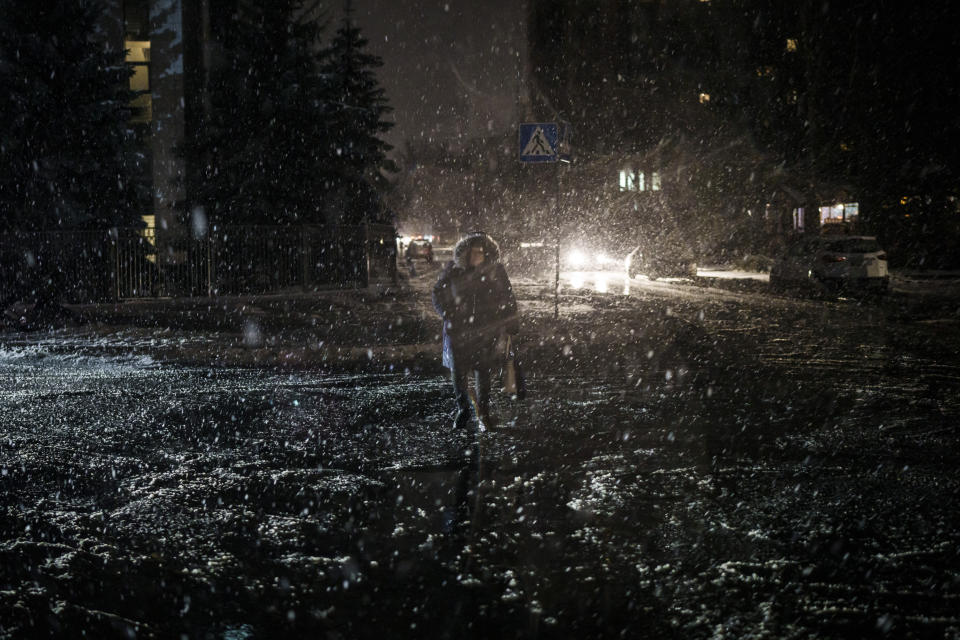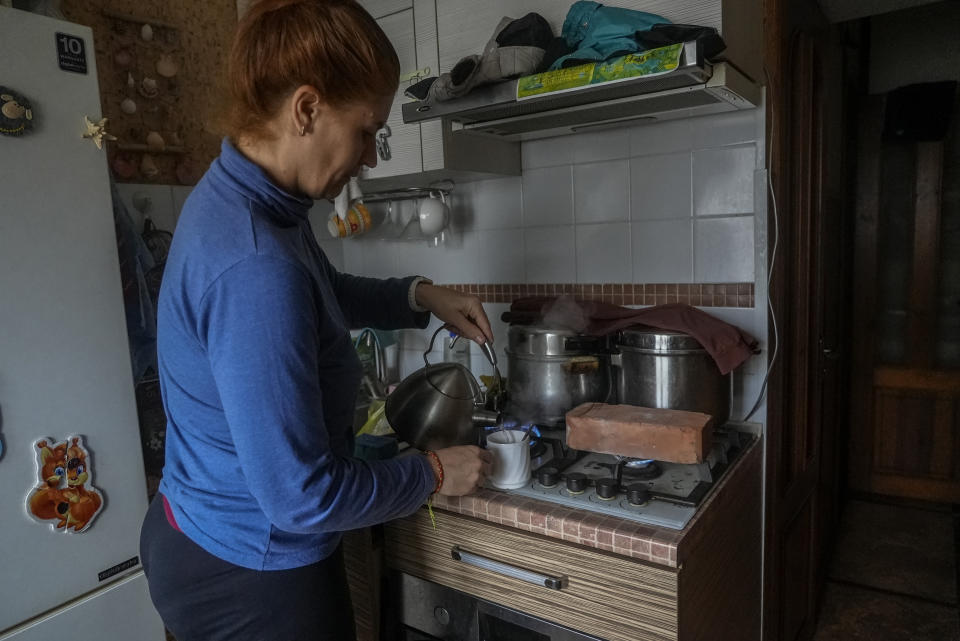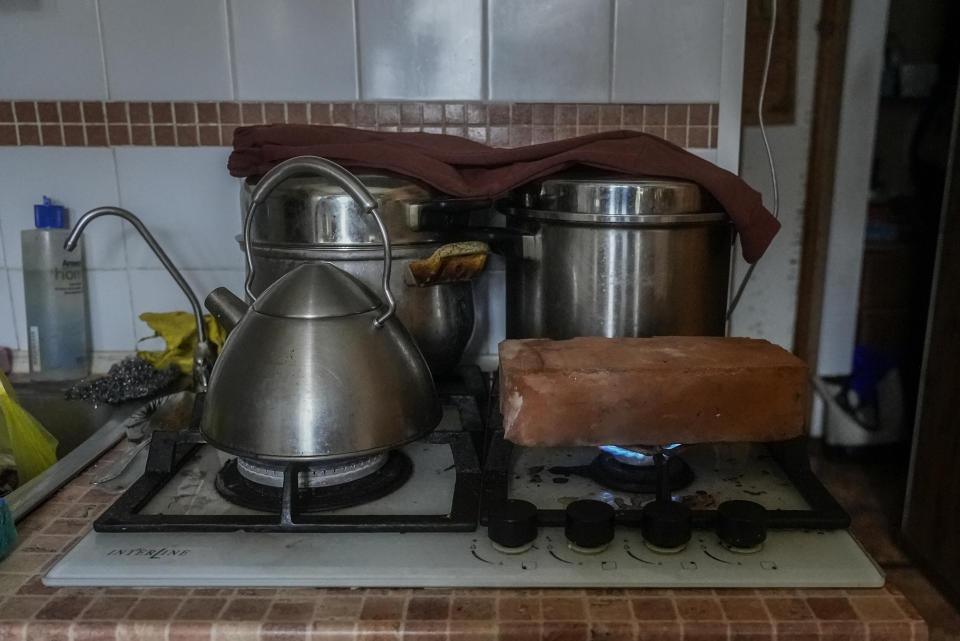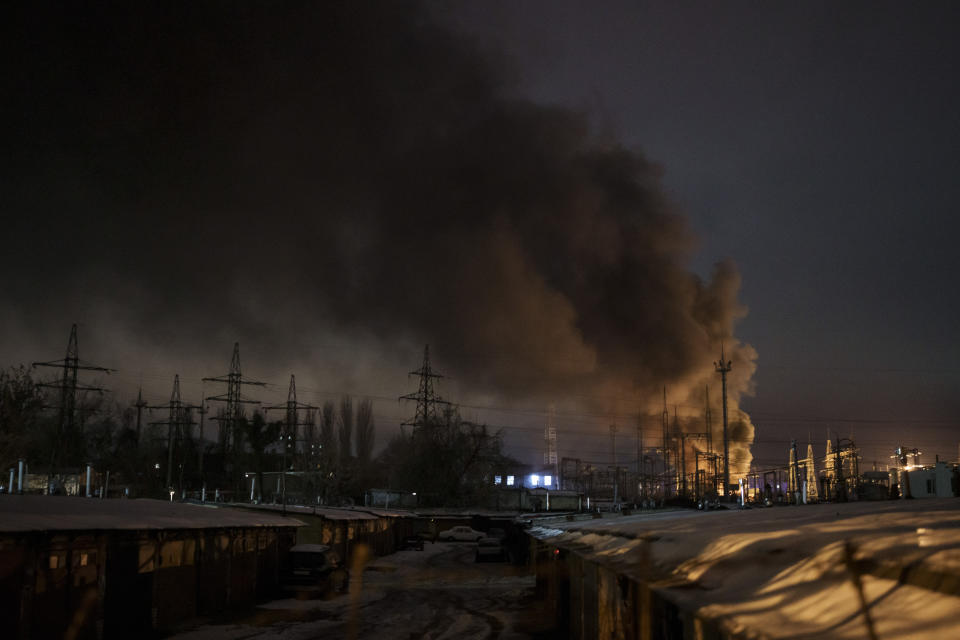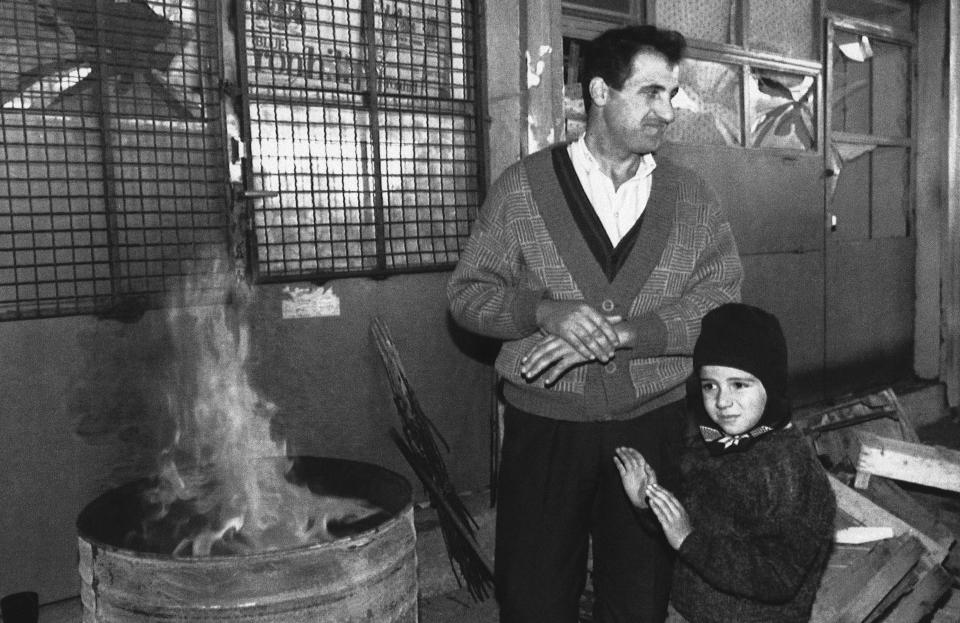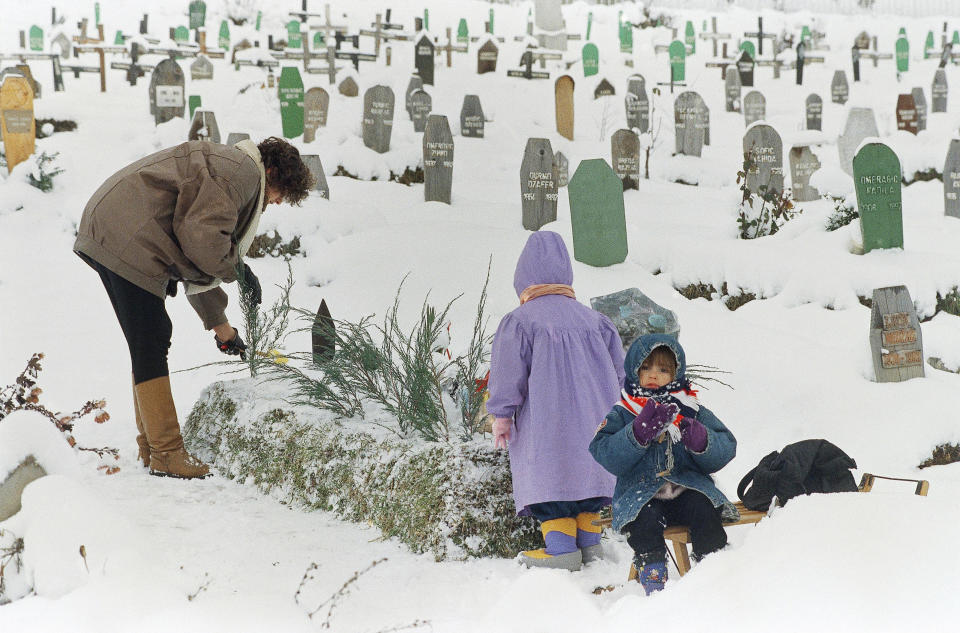Sarajevo’s agony echoes as Ukraine braces for a dark winter
- Oops!Something went wrong.Please try again later.
SARAJEVO, Bosnia-Herzegovina (AP) — Vildana Mutevelić huddled in her apartment with her two young children and elderly cousins. They had no heat, electricity or running water as artillery shells tore the roof off their building and almost took their lives.
To survive, she improvised.
Mutevelić made a lamp out of used engine oil, water and a shoelace for a wick. She cooked on a fire fueled by books, furniture, shoes or clothes. A plastic spoon, she discovered, when lit, worked well as a temporary flashlight if she ventured outside. Plastic sheets covered the blown-out windows, a flimsy buffer against the bitter cold. Her news of the world came from a neighbor who powered a radio with a car battery.
“The electricity failed right away,” Mutevelić, 70, said through a translator. “And everything we had in our freezers, it melted. Those were our stocks, basically. That’s all.”
For Mutevelić, these are memories from three decades ago, when Bosnian Serbs besieged Sarajevo, causing thousands of civilian casualties. But it’s all happening again in Ukraine. Russia’s armed forces have aimed their firepower at Ukraine’s energy infrastructure as winter weather sets in.
Ukraine President Volodymyr Zelenskyy, who has accused Russia of “energy terrorism," said earlier this week that about 9 million people were without electricity. The country’s prosecutor general, Andriy Kostin, told The Associated Press that Russia’s deliberate targeting of Ukraine’s essential utilities is another act of genocide, the most heinous of war crimes.
“We are convinced that the crimes (Russia) is committing in Ukraine bear all the hallmarks of genocide,” Kostin said in a statement. “The aggressor state is ‘weaponizing winter,’ depriving Ukrainians of the basics — electricity, water and heating.”
___
This story is part of an AP/FRONTLINE investigation that includes the War Crimes Watch Ukraine interactive experience and the documentary “ Putin’s Attack on Ukraine: Documenting War Crimes ” on PBS.
___
To make civilians suffer and die as a way to force their government to yield isn’t a new wartime strategy. But it’s prone to failure. Families, neighbors and entire communities band together, brainstorm and resist. As Sarajevo did. And as Britain did when the island nation refused to buckle under Nazi Germany’s withering assaults 80 years ago.
“The ability of a modern population to survive under duress and under aggression because of the mere willingness to continue to exist is sometimes underestimated,” said Bruno Tertrais, adviser for geopolitics at the Institut Montaigne, a Paris-based think tank.
Ukrainians are displaying the same resolve and ingenuity. Larysa Shevtsova’s apartment in Ukraine’s southern city of Kherson lost its electricity and water. But gas still flowed into a stove in the cramped kitchen. With two fire-resistant bricks and advice from a family friend, she and her husband were able to keep the temperature bearable in their home without being confined to the kitchen.
They’d set a brick directly on one of the stove’s four burners, the three others covered by large pots and a kettle. When the rectangular block was hot enough, it was carried carefully into the living room and set on top of a Soviet-era space heater that no longer worked. Shevtsova, her husband and two sons, one of them 3 years old, huddled around the brick for warmth that would last for about 30 minutes.
“We use this method to heat the room,” Shevtsova said. “Before that we just froze.”
The Associated Press and the PBS series “Frontline,” drawing from a variety of sources, have independently documented more than 40 attacks by Russia on Ukraine’s electrical power, heat, water and telecommunications facilities since February.
The extent of Russia’s path of destruction is not limited to one region of Ukraine. From the east to west, Russia has unleashed an onslaught of drone and missile attacks meant to inflict maximum damage to Ukraine’s energy infrastructure with a drastic uptick in strikes since September, according to AP’s analysis of the data.
The repeated attacks have left Ukrainians accustomed to daily blackouts to prevent overloading the system as temperatures continue to drop.
“We should be clear about what Russia is doing,” President Joe Biden said last week at the White House during a joint news conference with Zelenskyy. “It is purposefully attacking Ukraine’s critical infrastructure, destroying the systems that provide heat and light to the Ukrainian people during the coldest, darkest part of the year.”
Russia isn't slowing down its attacks on Ukraine’s energy grid. On Thursday, Russian missiles damaged power stations and other critical infrastructure in the biggest wave of strikes in weeks. Ukrainian military chief Gen. Valerii Zaluzhnyi said Russia fired 69 missiles at energy facilities and Ukrainian forces shot down 54.
In a tweet, Ukrainian Foreign Minister Dmytro Kuleba called the latest barrage of missiles “senseless barbarism."
Russian President Vladimir Putin has said the attacks are a response to an Oct. 8 truck bombing of the bridge connecting Russia’s mainland with the Crimean Peninsula, which Moscow annexed from Ukraine in 2014.
The World Health Organization has estimated that 2 million to 3 million Ukrainians will leave their homes this winter in search of warmth and safety.
“It is absolutely the case that terrorizing the civilian population, to break their morale, to get them to demand of their leaders that they surrender, is not a form of military necessity,” said Mary Ellen O’Connell, a University of Notre Dame law professor and expert on international law. “Even if you’re attacking a military objective, if the intent in doing so is to terrorize civilians then you have committed a war crime.”
Since the start of Russia’s invasion in February, Moscow has launched 168 missile strikes on Ukraine’s energy infrastructure, with nearly 80 percent of the attacks occurring in October, November and December, according to Kostin. Ukraine’s state-controlled Naftogaz oil and gas company reported earlier this month that more than 350 of its facilities and 450 kilometers (279 miles) of gas pipelines had sustained damage.
Russia made Ukraine’s electrical grid its primary target “because it’s the easiest way to disrupt civilization and to create humanitarian catastrophe,” Volodymyr Kudrytskyi, the CEO of state-owned power grid operator NEC Ukrenergo, told the AP. Without electricity, he said, basic utilities and other critical infrastructure sectors, such as communications and health care, are crippled.
“No transmission system operator in the world ever encountered this large scale of destruction,” Kudrytskyi said.
NEC Ukrenergo has described on Facebook how hundreds of its technicians and specialists are dispatched to restore power when it’s knocked out by “patching what can be patched and replacing what can be replaced.” But it can be at times a Sisyphean task. Russian shelling in early December cut off power in much of the newly liberated Ukrainian city of Kherson just days after it had been restored.
Sarajevans experienced the same descent into darkness and cold in the mid-1990s when Serb forces laid siege to the Bosnian capital during the bloody breakup of Yugoslavia. Like Ukraine, Bosnia faced an existential threat from a neighboring nation that sought to control the country by carving it up.
A glaring difference between Sarajevo and Ukraine is the Western world’s response.
For nearly four years, Sarajevo’s roughly 350,000 residents were trapped and faced daily shelling and sniper attacks. Cut off from regular access to electricity, heat and water, they survived on limited humanitarian aid from the United Nations while drinking from wells and foraging for food.
Fearing more bloodshed and seeking a political solution, the United States and the European Community, the European Union’s predecessor, backed a U.N. arms embargo on the former Yugoslavia that blocked the Bosnian government from acquiring weapons to fight back against Serb attacks.
For Ukraine, money and weapons are flowing. The United States has delivered or pledged billions of dollars in military aid, including a Patriot surface-to-air missile battery, the most powerful such weapon committed to Ukraine yet.
“Ukraine has weapons. And what we got back then was an embargo on weapons,” said Mirza Mutevelić, the 38-year-old son of Vildana Mutevelić. “I perceive this as another injustice.”
Lamija Polic, a retired nurse in Sarajevo, dodged bullets to get water and used a metal garbage can as a stove. Firewood was hard to come by. By the summer of 1993, most of Sarajevo’s trees were gone and people were digging up tree stumps.
“So we burned everything we had: slippers, shoes, old clothes, books, you name it,” Polic said. “We heated the smallest room in our flat, the kitchen, and we spent all the time there. You build a fire, but it lasts for just a few minutes and then you wait until you can no longer stand the cold to build another one. I remember that our blankets and sheets were so cold that you had a sense they were wet.”
Some residents of Kherson, a city on the Dnieper River in southern Ukraine, are facing similar hardship. The city was the only regional capital that Moscow’s forces seized, falling into Russian hands in the first days of the invasion, and it was occupied for nearly nine months.
As they retreated in November, Russian forces wrecked power lines and other key infrastructure, sending thousands of Kherson’s newly liberated residents into the dark.
Larysa, who declined to use her last name for fear of reprisals against her family, told the AP in late November that at times she felt like she was having a nervous breakdown.
Unlike many houses that are able to use gas, Larysa’s home relied solely on electricity. So when Russian soldiers damaged energy supply lines, she and her husband were left in the dark, unable to cook or take hot showers. So they ate canned mackerel, pates and porridge without meat in the dark in their freezing apartment.
About once a week, Larysa went to a friend’s house that still had gas to wash her hair in warm water and eat a home-cooked meal. She and her husband wanted to buy a portable generator, but prices had spiked from about $190 to more than $1,600, Larysa said.
“I am tired of all of this and want my old life back,” Larysa said.
In Kyiv, Ukraine’s capital, Mariia Modzolevska has relied on a generator and a car battery to keep her cafe, Blukach, up and running through the almost daily power outages.
Customers still come in. They charge their mobile phones and other gadgets while drinking the cafe’s coffee and eating its sweet small bites. Modzolevska, 34, devised ways to keep her shop powered. An old, recharged car battery keeps the credit card machine running. A diesel generator powers the espresso machines.
“We were making money until the first drone attack and blackouts, then income dropped by 30-plus percent,” she said. “It’s come back up ever since we equipped the coffee shop with power and internet. I don’t know for how long we may operate in (the) future.”
Tetiana Boichenko’s corner apartment in Kyiv faces north. Even in November, her bedroom was cold. Heat and electricity came and went in her neighborhood, depending on whether Russian missiles hit their targets.
Boichenko bought a small tent for $10 and set it up on top of her bed. Inside the tent, on top of a few blankets, Boichenko was 3 to 4 degrees warmer than the temperature of her room. Boichenko said she doesn’t plan to take down her tent until spring.
“I will sleep in it because it is warm,” she said.
___
Dupuy reported from New York, Lardner from Washington, and Niksic from Sarajevo. Associated Press writers Sam Mednick and Inna Varenytsia in Kherson, and Jamey Keaten in Kyiv contributed to this report.
___
Corrects spelling of Russian president’s name to Vladimir, not Vladmir.
